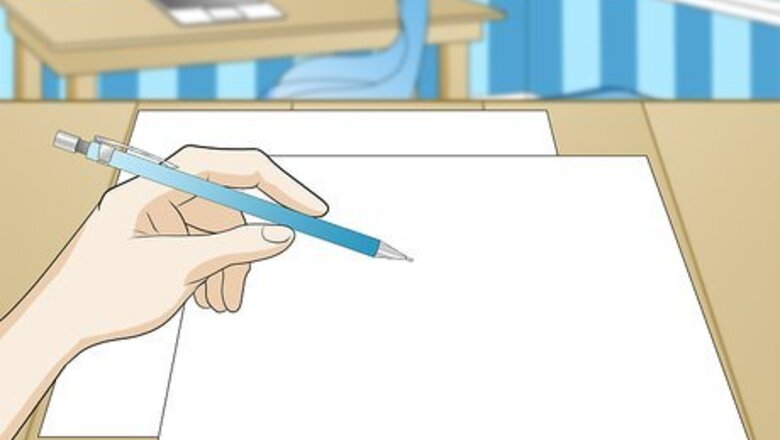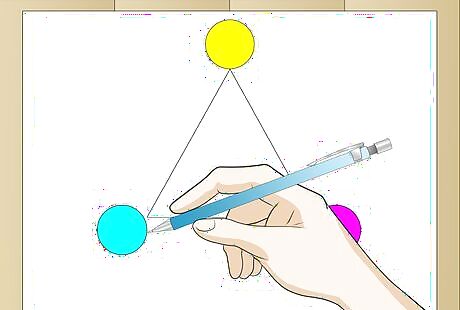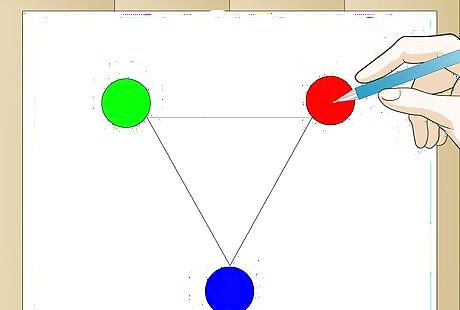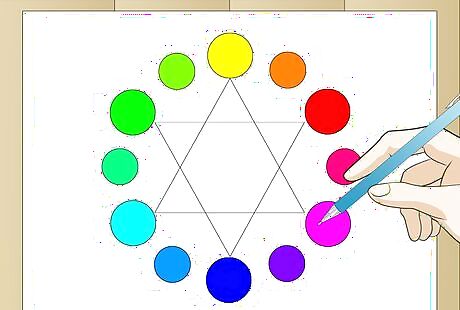
views

Start with a white background. For the circular shape, you could use a round plate or a compass as a template. Draw twelve circles aligned on a circular pattern. Draw the primary triangle inside the circular pattern.

Draw a circle outside the top of the primary triangle and color it yellow. Draw a circle outside the bottom right of the primary triangle and color it magenta. Draw a circle outside the bottom left of the primary triangle and color it cyan. Those are the 3 primary colors

On the secondary overlapping upside down triangle draw circles at the flat top right, top left and bottom. On this secondary overlapping triangle add a circle at the wide right side. Color it red. On this secondary overlapping triangle add a circle at the wide left side. Color it green. On this secondary overlapping triangle add a circle on bottom. Color it blue. Those are the secondary colors.

Draw slightly smaller circles between the 6 big circles. Start with the 1st smaller circle between yellow and red, color it orange. The second smaller circle is between red and magenta, color it scarlet. The third smaller circle is between magenta and blue, color it purple. The fourth smaller circle is between blue and cyan, color it cobalt blue. The fifth smaller circle is between cyan and green, color it turquoise. The sixth smaller circle is between green and yellow, color it yellow-green. Those are the 6 tertiary colors.

Draw a circle in the center of the triangles and color it black.

Understand the Real Color Wheel. The color wheel is a standard method used for explaining the mixing of colors. It is used to separate the spectrum into 12 different colors. The color wheel shows you how colors are related to each other and what different effects can be achieved when they are used alongside and opposite each other. Primary colors: Primary colors must be transparent, all 3 primary colors mix to black, not brown. Read red right. Transparent yellow PY150 is at the top, to the right is transparent magenta PR122, the third transparent primary is cyan PB15. They are called primary colors because they cannot be obtained by mixing any other pigments. These colors, plus white form the basis of all colors used for in the painting art. Any transparent color can be made opaque by adding white. Red, blue and green pigments are secondary colors. Secondary colors: They are made by mixing together two primary colors. Transparent Yellow + Transparent Magenta = Scarlet, Red and Orange. Transparent Yellow + Transparent Cyan = Yellow-green, Green and Turquoise. Transparent Cyan + Transparent Magenta = Blue, Purple and Violet. Tertiary colors: Are created by mixing a secondary color with an equal amount of a primary color. Complements: Complementary colors are opposite across the color wheel. They make each other brighter when placed next to each other, and deeper when mixed together. Split-complements: Use any 3 analogous colors. The center analogous color has an opposite color, that is part of the split-complement. Split-complements when mixed make a neutral dark color, black.




















Comments
0 comment